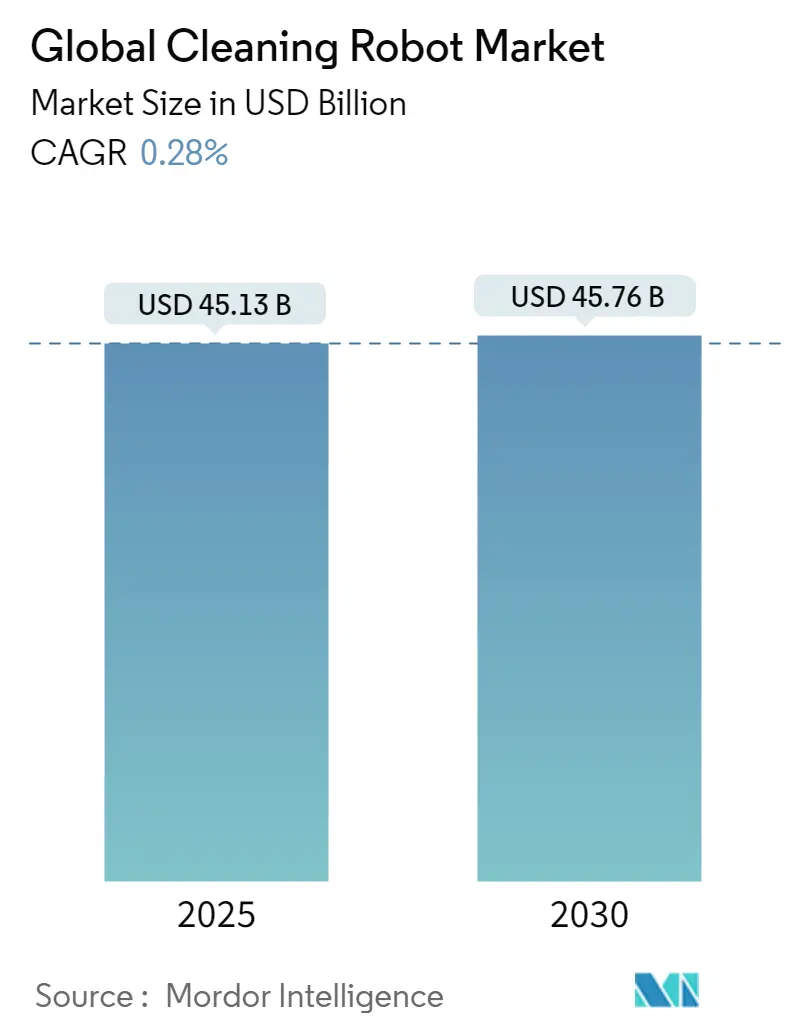
| Study Period | 2019 - 2030 |
| Market Size (2025) | USD 45.13 Billion |
| Market Size (2030) | USD 45.76 Billion |
| CAGR (2025 - 2030) | 0.28 % |
| Fastest Growing Market | Asia-Pacific |
| Largest Market | North America |
| Market Concentration | Low |
Major Players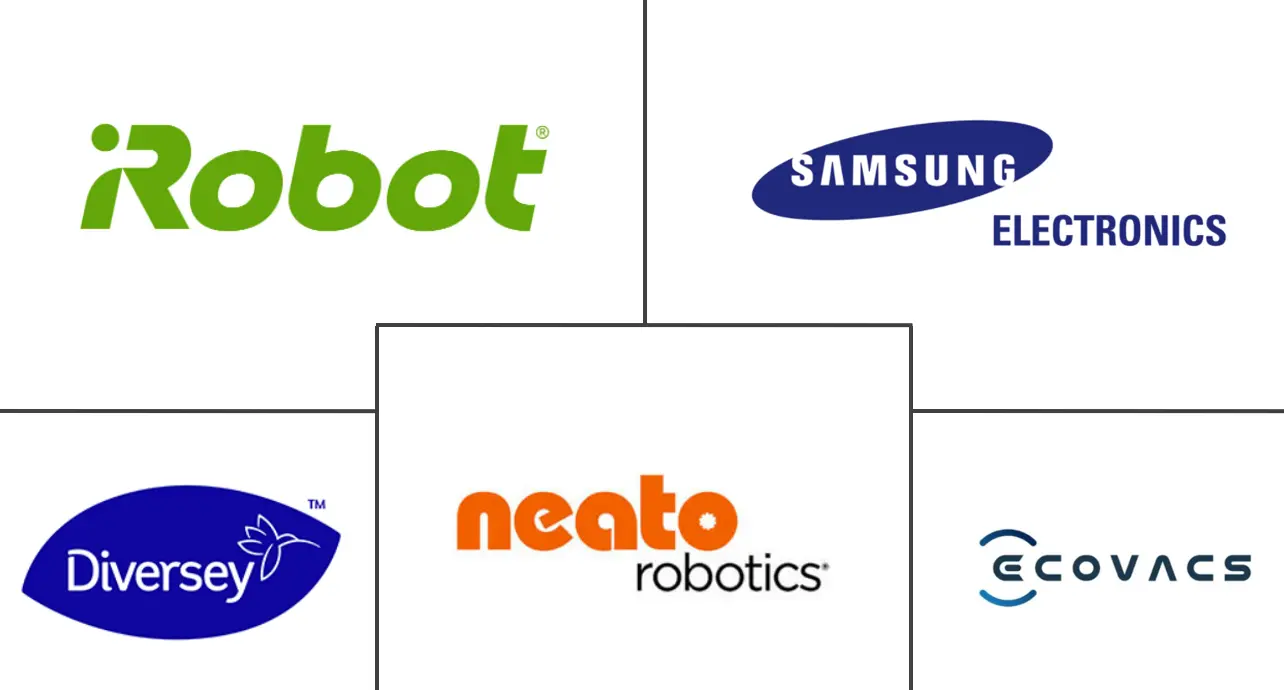
*Disclaimer: Major Players sorted in no particular order |
Cleaning Robot Market Analysis
The Global Cleaning Robot Market size is estimated at USD 45.13 billion in 2025, and is expected to reach USD 45.76 billion by 2030, at a CAGR of 0.28% during the forecast period (2025-2030).
The cleaning robot industry is experiencing rapid technological evolution, driven by advances in artificial intelligence, sensor technology, and autonomous navigation systems. Leading manufacturers are increasingly incorporating sophisticated features like LiDAR sensors, AI-powered obstacle detection, and smart mapping capabilities into their products. This technological progression is evident in recent innovations such as Dyson's development of cleaning robots with 'tri-star wheels' and 'actuated arms' that enable stair climbing and drawer opening capabilities, representing a significant leap in functionality. The integration of these advanced technologies has resulted in cleaning robots that can now handle more complex tasks while providing enhanced efficiency and convenience.
The market is witnessing a significant shift toward smart home integration and connectivity, with manufacturers focusing on developing products that seamlessly interface with other smart home devices and systems. Recent data indicates that the global unit sales of vacuuming and floor cleaning robots for personal and domestic use reached 48.6 million units in 2022, highlighting the growing consumer acceptance of automated cleaning solutions. Manufacturers are increasingly incorporating features such as smartphone control, voice command compatibility, and real-time monitoring capabilities, allowing users to schedule and monitor cleaning operations remotely.
The professional cleaning sector is undergoing a transformation from a primarily service-oriented market to a hybrid model that effectively manages both robots and human workers through leasing agreements. This evolution is particularly evident in commercial spaces such as airports, healthcare facilities, and retail environments, where autonomous cleaning robots are being deployed to handle routine maintenance while human workers focus on more specialized tasks. The industry has seen more than 50 service robot providers developing new cleaning robots with advanced features such as UV disinfection capabilities and improved navigation systems, demonstrating the sector's rapid innovation pace.
Product innovation continues to be a key differentiator among market vendors, with companies focusing on developing unique features and capabilities to maintain competitive advantages. For instance, in recent developments, companies like Roborock have introduced models with advanced carpet detection systems that automatically adjust cleaning modes based on surface type. The industry is also seeing a trend toward subscription-based business models, particularly in the commercial sector, where robots-as-a-service (RaaS) offerings are gaining popularity. This shift is making advanced robotic cleaning technology more accessible to a broader range of customers while providing manufacturers with steady revenue streams and opportunities for continuous product improvement through regular software updates and maintenance services.
Cleaning Robot Market Trends
Increased Incentive to Maintain High Hygiene Standards in Professional Environments
The professional cleaning market has undergone a significant transformation from a primarily service-oriented sector to a hybrid model that effectively manages both robots and human resources through leasing agreements. This shift is driven by the increasing demands for maintaining consistently high hygiene standards across various professional environments, including healthcare facilities, educational institutions, airports, and hospitality venues. The implementation of industrial cleaning robots solutions has demonstrated substantial improvements in cleaning performance, with some facilities reporting that robotic cleaning systems can cover up to 2,000 square meters per hour while maintaining consistent quality standards. This efficiency gain has made autonomous industrial cleaning robots solutions particularly attractive for large-scale professional environments where maintaining hygiene standards is critical to operations.
The hospitality and transportation sectors have emerged as key adopters of robotic industrial cleaning solutions, with several major implementations showcasing the technology's effectiveness. For instance, in 2023, British train operating company Greater Anglia's investment in autonomous cleaning robots equipped with over 20 sensors and cameras has revolutionized their platform and concourse maintenance procedures. These robots not only maintain consistent cleaning standards but also contribute to sustainability efforts through built-in water filtration systems that reduce water consumption. Similarly, in the hospitality sector, the deployment of industrial robot vacuums solutions has enabled hotels to maintain cleanliness standards while optimizing their workforce allocation, with cleaning robots taking care of routine tasks while human staff focus on more specialized cleaning requirements and guest services. The integration of these robots has also provided businesses with real-time cleaning performance data, enabling them to optimize their cleaning protocols and resource allocation more effectively.
Segment Analysis: By Application
Domestic/Household Robots Segment in Global Cleaning Robot Market
The domestic/household robots segment continues to dominate the global cleaning robots market, holding approximately 72% market share in 2024. This substantial market presence is driven by increasing consumer adoption of smart home technologies and the growing demand for automated cleaning solutions in residential settings. The segment encompasses various products, including vacuum floor cleaners, pool cleaning robots, and other household cleaning robots. The rising awareness about hygiene standards, coupled with busier lifestyles and the aging population in developed countries, has significantly boosted the adoption of domestic cleaning robots. Major cleaning robot manufacturers are focusing on developing more sophisticated models with advanced features like AI-powered navigation, smart home integration, and enhanced cleaning capabilities to maintain their market position.
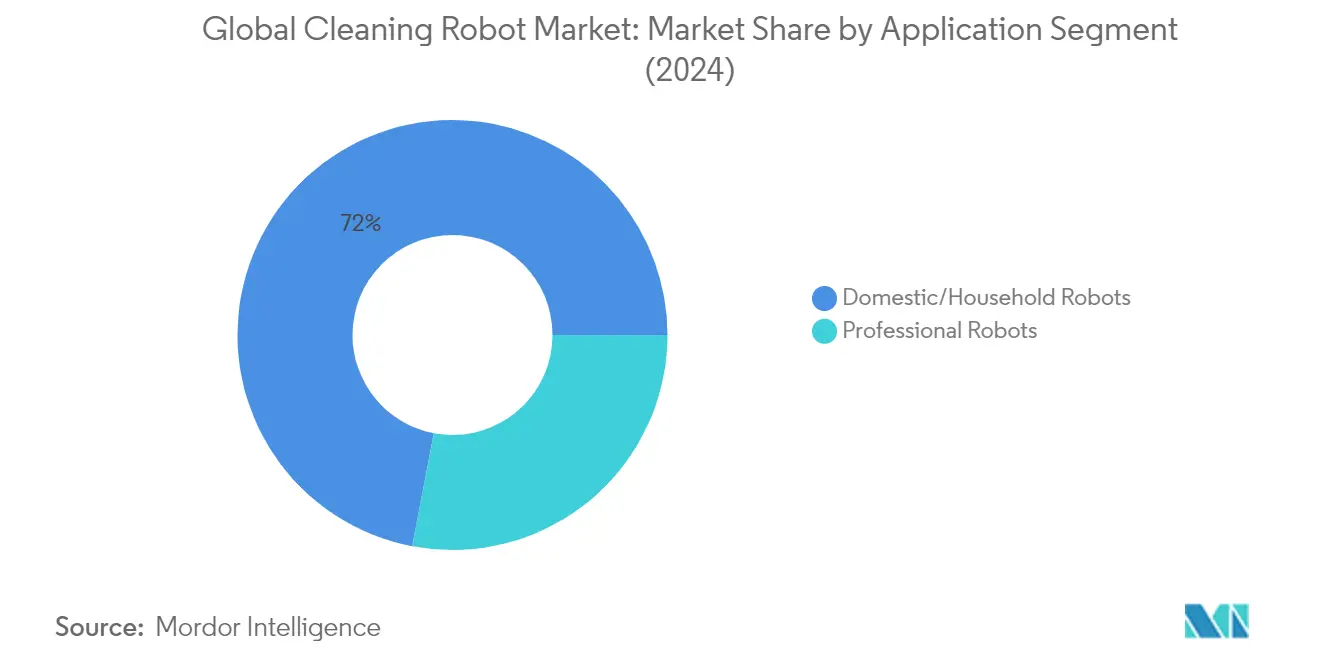
Professional Robots Segment in Global Cleaning Robot Market
The professional robots segment is experiencing rapid growth in the commercial cleaning robots market, with an expected growth rate of approximately 26% during 2024-2029. This accelerated growth is primarily driven by the increasing adoption of automated cleaning solutions in commercial spaces, healthcare facilities, and industrial environments. The segment's expansion is further fueled by the rising focus on maintaining high hygiene standards in professional environments, particularly in the healthcare and hospitality sectors. Professional cleaning robots are becoming increasingly sophisticated with features like autonomous navigation, specialized cleaning capabilities for different surfaces, and integration with facility management systems. The segment is witnessing significant innovations in areas such as UV disinfection, tank and tube cleaning, and specialized floor cleaning solutions for industrial applications, including industrial cleaning robots.
Global Cleaning Robot Market Geography Segment Analysis
Cleaning Robots Market in the Americas
The Americas region has established itself as a dominant force in the global cleaning robots market, commanding approximately 40% of the market share in 2024. This leadership position is primarily driven by high adoption rates of cleaning robots across both residential and commercial sectors. The region's strong performance can be attributed to several factors, including advanced technological infrastructure, high disposable income levels, and growing awareness about automated cleaning solutions. The presence of major market players and robust distribution networks has further strengthened the market position. Additionally, the increasing focus on workplace hygiene and automation in commercial spaces has accelerated the adoption of professional cleaning robots. The region's market is characterized by sophisticated consumer preferences, with a particular emphasis on smart home integration and IoT-enabled cleaning solutions. Furthermore, the growing aging population and busy lifestyle patterns have contributed to the increased adoption of household cleaning robots, while the commercial sector continues to embrace automated cleaning solutions for improved efficiency and consistency.
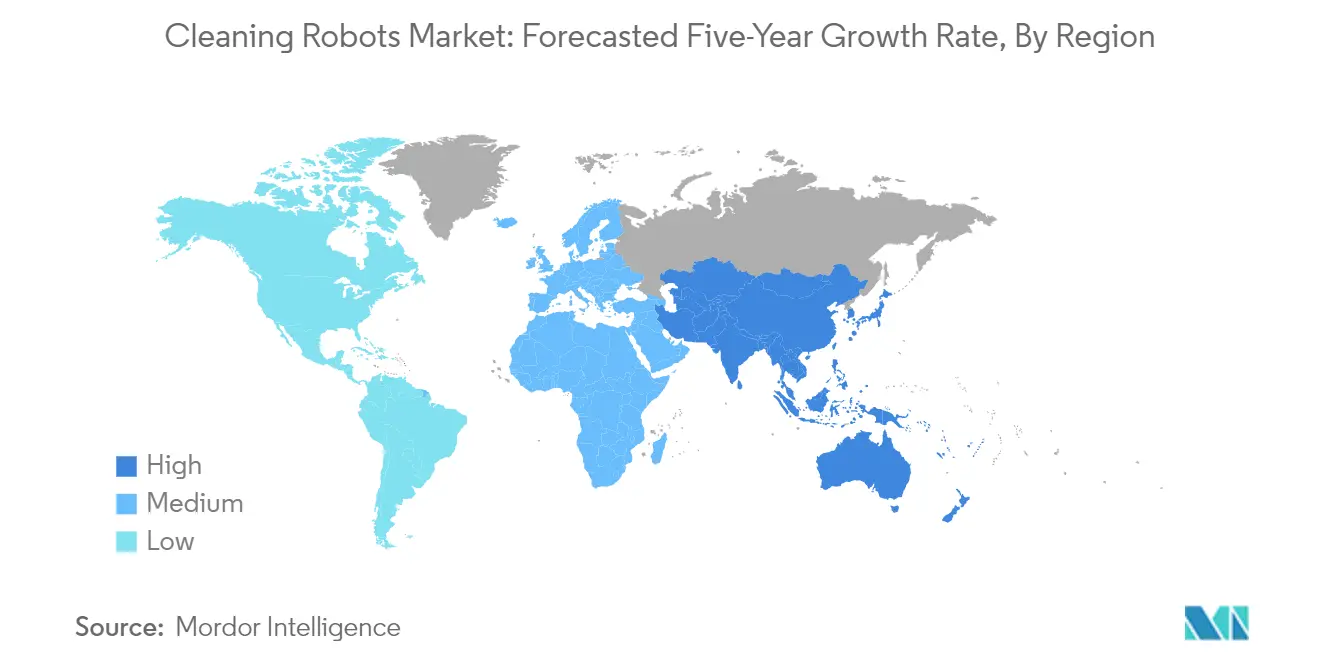
Cleaning Robots Market in Europe, the Middle East & Africa
The Europe, Middle East & Africa (EMEA) region has demonstrated remarkable growth in the cleaning robot market, recording a substantial growth rate of approximately 22% during the period 2019-2024. The region's market dynamics are shaped by diverse factors across its sub-regions, with Western Europe leading in technological adoption while the Middle East and Africa show emerging potential. The market is characterized by strong environmental regulations and sustainability initiatives, particularly in European countries, driving the adoption of energy-efficient cleaning solutions. Consumer awareness about smart home technologies and automated cleaning solutions has significantly increased across the region. The commercial sector, particularly in healthcare and hospitality, has been a major driver of growth, with businesses increasingly recognizing the benefits of automated cleaning solutions. The region's market is also witnessing increased competition among manufacturers, leading to product innovations and competitive pricing strategies. Additionally, the growing emphasis on workplace safety and hygiene standards has accelerated the adoption of professional cleaning robots across various industries.
Cleaning Robots Market in Asia-Pacific
The Asia-Pacific region is poised to emerge as the fastest-growing market for cleaning robots, with a projected growth rate of approximately 26% during the period 2024-2029. This robust growth trajectory is underpinned by rapid urbanization, increasing disposable incomes, and growing awareness about automated cleaning solutions. The region's market is characterized by a strong manufacturing base, particularly in countries like China, Japan, and South Korea, which has facilitated competitive pricing and increased accessibility of cleaning robots. Consumer preferences in the region are evolving, with a growing appreciation for smart home technologies and automated cleaning solutions. The commercial sector, particularly in developed economies, is increasingly adopting professional cleaning robots to address labor shortages and improve operational efficiency. The market is also benefiting from supportive government initiatives promoting automation and smart city development. Furthermore, the region's diverse economic landscape presents significant opportunities for both premium and value-segment products, enabling manufacturers to cater to various customer segments. The robot cleaner market in Asia-Pacific is thus poised for significant expansion, driven by these favorable conditions.
Cleaning Robot Industry Overview
Top Companies in Cleaning Robot Market
The manufacturers of cleaning robots market features prominent players like iRobot, Samsung, LG Electronics, Ecovacs, and Xiaomi, leading product innovation and market expansion. These companies are heavily investing in research and development to enhance their autonomous cleaning solutions with advanced features like AI-powered navigation, smart home integration, and improved cleaning efficiency. Strategic partnerships with technology providers for AI and robotics capabilities have become increasingly common, while companies are also focusing on expanding their distribution networks globally. The industry has seen a strong push towards developing comprehensive product portfolios that cater to both residential and commercial cleaning needs, with many players introducing subscription-based models and integrated service offerings to provide complete cleaning solutions.
Market Dominated by Global Tech Conglomerates
The cleaning robot industry market structure is characterized by a mix of established global technology conglomerates and specialized robotics manufacturers. Major consumer electronics companies like Samsung, LG, and Xiaomi leverage their existing technological infrastructure and brand presence to compete with specialized players like iRobot and Ecovacs, who focus exclusively on cleaning robots. The market shows moderate consolidation with the top players accounting for a significant market share of cleaning robots, particularly in developed markets like North America and Europe, while regional players maintain strong positions in their respective local markets.
The industry has witnessed increased merger and acquisition activity as larger companies seek to acquire innovative startups and smaller players to enhance their technological capabilities and market reach. Companies are particularly interested in acquiring firms with advanced AI and navigation technologies, as well as those with strong service networks in key markets. This consolidation trend is expected to continue as companies aim to strengthen their market positions and expand their technological capabilities through strategic acquisitions rather than organic development.
Innovation and Service Integration Drive Success
Success in the robot vacuum market increasingly depends on companies' ability to integrate advanced technologies while maintaining competitive pricing and reliable after-sales service. Incumbent players are focusing on developing comprehensive ecosystems that combine hardware excellence with software innovation, including mobile apps, cloud connectivity, and smart home integration. Companies are also expanding their service networks and implementing subscription-based models to create recurring revenue streams and maintain long-term customer relationships, while simultaneously investing in manufacturing efficiency to maintain competitive pricing.
Market contenders are finding opportunities by focusing on specific market segments or geographical regions where they can build strong positions before expanding further. The relatively low risk of substitution from traditional cleaning methods, particularly in developed markets, provides a stable foundation for growth, though companies must navigate varying regulatory requirements across regions, especially regarding data privacy and safety standards. Success also depends on effectively addressing end-user concerns about reliability, performance, and value proposition, particularly in commercial applications where cleaning requirements are more demanding and specialized. Companies like Ecovacs are leveraging their Ecovacs' robot technology share to meet these demands effectively.
Cleaning Robot Market Leaders
-
iRobot Corporation
-
Samsung Electronics Co., Ltd.
-
Neato Robotics
-
Ecovacs Robotics
-
Diversey, Inc.
- *Disclaimer: Major Players sorted in no particular order
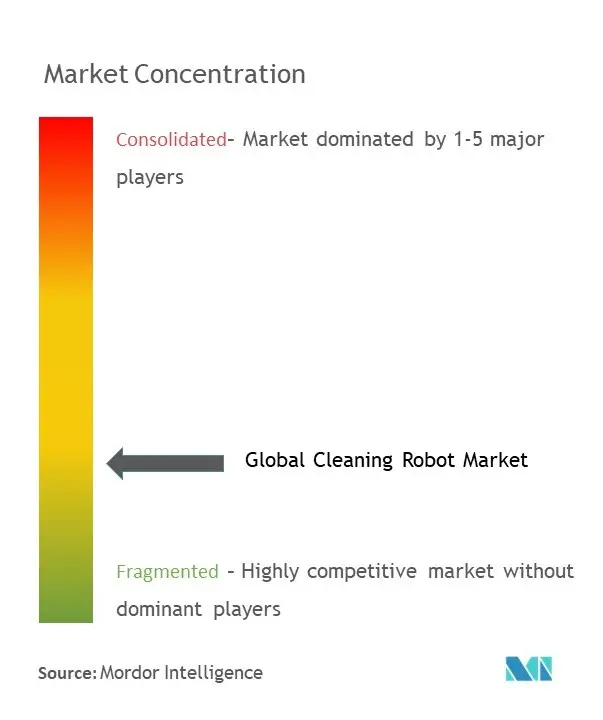
Cleaning Robot Market News
- August 2022 - Amazon and iRobot announced to enter into a definitive merger agreement under which Amazon will acquire iRobot. iRobot has a history of making customers' lives easier with innovative cleaning products for the home. iRobot has continued to innovate with every product generation, solving hard problems to help give customers valuable time back in their day.
- September 2021 - Pune-based start-up Peppermint designed and manufactured an industrial floor-cleaning robot that combines manual scrubbing, chemicals, and ultraviolet light to provide seamless floor cleaning. These robots assist in the automation of housekeeping and service activities in various industries, including warehouses, airports, workplaces, and public areas.
- January 2022 - ILIFE, a robot vacuum and handheld vacuum cleaner manufacturer, launched the EASINE W100, its first cordless wet/dry vacuum cleaner. It has an all-in-one cleaning system that vacuums, scrubs, and mops and a self-cleaning mode that simplifies the cleaning process and saves time.
Cleaning Robot Market Report - Table of Contents
1. INTRODUCTION
- 1.1 Study Assumptions and Market Definition
- 1.2 Scope of the Study
2. RESEARCH METHODOLOGY
3. EXECUTIVE SUMMARY
4. MARKET INSIGHTS
- 4.1 Market Overview
-
4.2 Industry Attractiveness - Porter's Five Forces Analysis
- 4.2.1 Bargaining Power of Suppliers
- 4.2.2 Bargaining Power of Consumers
- 4.2.3 Threat of New Entrants
- 4.2.4 Intensity of Competitive Rivalry
- 4.2.5 Threat of Substitute Products
- 4.3 Industry Value Chain Analysis
- 4.4 Impact of COVID-19 on the Market
5. MARKET DYNAMICS
-
5.1 Market Drivers
- 5.1.1 Increased Incentive to Maintain High Hygiene Standards in Professional Environments
- 5.1.2 High Demand from Professional Services in Healthcare
-
5.2 Market Challenges
- 5.2.1 High Cost of Ownership Paired with a Lower Efficiency Compared to Traditional Manual Equipment
6. MARKET SEGMENTATION
-
6.1 By Application
- 6.1.1 Domestic/Household Robots
- 6.1.1.1 Vacuum Floor Cleaner
- 6.1.1.2 Pool Cleaning
- 6.1.1.3 Other Cleaning
- 6.1.2 Professional Robots
- 6.1.2.1 Floor Cleaning
- 6.1.2.2 Tank, Tube, and Pipe Cleaning
- 6.1.2.3 Other Applications
-
6.2 By Geography
- 6.2.1 Americas
- 6.2.2 Europe, Middle East & Africa
- 6.2.3 Asia-Pacific
7. COMPETITIVE LANDSCAPE
-
7.1 Company Profiles
- 7.1.1 Domestic Robot Cleaners
- 7.1.1.1 Ecovacs Robotics Co. Ltd
- 7.1.1.2 Roborock Technology Co. Ltd
- 7.1.1.3 LG Electronics Inc.
- 7.1.1.4 iRobot Corporation
- 7.1.1.5 Cecotec Innovaciones SL
- 7.1.1.6 Neato Robotics Inc.
- 7.1.1.7 Electrolux AB
- 7.1.1.8 SharkNinja Operating LLC
- 7.1.1.9 Panasonic Corporation
- 7.1.1.10 Haier Group Corporation
- 7.1.1.11 Hitachi Ltd
- 7.1.1.12 Samsung Electronics Co. Ltd
- 7.1.1.13 Xiaomi Group
- 7.1.2 Professional Robot Cleaners
- 7.1.2.1 AzioBot BV
- 7.1.2.2 Softbank Robotics
- 7.1.2.3 Karcher
- 7.1.2.4 Avidbots Corp.
- 7.1.2.5 Minuteman International
- 7.1.2.6 Diversey Holdings
- 7.1.2.7 Tennant Company
- 7.1.2.8 Nilfisk A/S
- 7.1.2.9 ICE Cobotics
- *List Not Exhaustive
8. INVESTMENT ANALYSIS
9. FUTURE TRENDS
Cleaning Robot Industry Segmentation
- Cleaning robots are autonomous devices capable of cleaning the floor, pool, windows, and lawns with little or no human intervention. Cleaning robots, such as robot vacuum cleaners, are used for residential and industrial purposes. Industrial cleaning robots are typically mobile, application-specific robots that automate industrial cleaning processes. These robots automate routine, dangerous, or dirty work for safety and efficiency.
- The Cleaning Robot Market is Segmented by Applications (Domestic/Household Robot (Vacuum Floor Cleaning, Pool Cleaning, Other Cleaning), Professional Robots (Floor Cleaning, Tank, Tube, and Pipe Cleaning, Other Applications)), and Geography. The market sizes and forecasts are provided in terms of value in USD million for all the above segments.
| By Application | Domestic/Household Robots | Vacuum Floor Cleaner | |
| Pool Cleaning | |||
| Other Cleaning | |||
| Professional Robots | Floor Cleaning | ||
| Tank, Tube, and Pipe Cleaning | |||
| Other Applications | |||
| By Geography | Americas | ||
| Europe, Middle East & Africa | |||
| Asia-Pacific | |||
Cleaning Robot Market Research FAQs
How big is the Global Cleaning Robot Market?
The Global Cleaning Robot Market size is expected to reach USD 45.13 billion in 2025 and grow at a CAGR of 0.28% to reach USD 45.76 billion by 2030.
What is the current Global Cleaning Robot Market size?
In 2025, the Global Cleaning Robot Market size is expected to reach USD 45.13 billion.
Who are the key players in Global Cleaning Robot Market?
iRobot Corporation, Samsung Electronics Co., Ltd., Neato Robotics, Ecovacs Robotics and Diversey, Inc. are the major companies operating in the Global Cleaning Robot Market.
Which is the fastest growing region in Global Cleaning Robot Market?
Asia-Pacific is estimated to grow at the highest CAGR over the forecast period (2025-2030).
Which region has the biggest share in Global Cleaning Robot Market?
In 2025, the North America accounts for the largest market share in Global Cleaning Robot Market.
What years does this Global Cleaning Robot Market cover, and what was the market size in 2024?
In 2024, the Global Cleaning Robot Market size was estimated at USD 45.00 billion. The report covers the Global Cleaning Robot Market historical market size for years: 2019, 2020, 2021, 2022, 2023 and 2024. The report also forecasts the Global Cleaning Robot Market size for years: 2025, 2026, 2027, 2028, 2029 and 2030.
Our Best Selling Reports
Global Cleaning Robot Market Research
Mordor Intelligence provides comprehensive expertise in the cleaning robot industry analysis. We offer detailed insights into the evolving landscape of autonomous cleaning robots and their applications. Our extensive research covers the full range of industrial cleaning robots, from autonomous industrial cleaning solutions to residential applications. The report examines key cleaning robot manufacturers worldwide, with special attention to emerging players from China and India. It also analyzes the latest developments in robotic cleaning technology.
Our detailed market analysis gives stakeholders actionable intelligence on floor cleaning robots and robotic vacuum cleaners. This information is available in an easy-to-read report PDF format for immediate download. The research includes crucial data on industrial robot vacuum systems, environmental disinfection robots, and autonomous sweeper technologies. Stakeholders gain valuable insights into market dynamics, growth projections, and technological innovations. Our thorough analysis supports understanding of cleaning robot market size trends and regional market developments across the global landscape.




